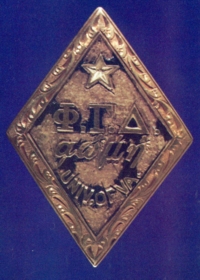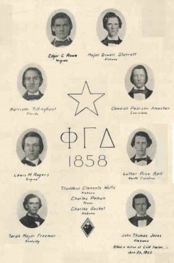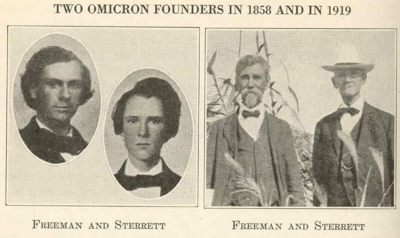The Archives of Phi Gamma Delta
Archives Home Founders Traditions Today in History Historic Sites Leaders Exhibits/References Contact
______________________________________________________________________
Duels, Digs, and Delta
 Back to Historic Badges page
Back to Historic Badges page
For 116 years it lay where it had fallen. With each successive season it burrowed a little deeper. The location - a flat hilltop out of sight of the Yankees across the river, on the lower edge of a large estate called "Westwood" in the Dumfries area of Northern Virginia. During the summer and fall of 1861, young men from Alabama, Virginia, Mississippi and probably elsewhere were in bivouac at this site, which they called Camp Law. In the histories of the Civil War it seems to have been forgotten. There is little record of it.
Our nation has a fascination for the "War Between the States," and out of this interest has developed a special sport or hobby, though neither word seems to fit properly. Calling themselves relic hunters, they carefully research their quarry, studying troop unit movements, camp sites, and the skirmish areas. The electronic metal detector has proven invaluable to the hunters, helping them to more quickly stay ahead of the bulldozers, which are fast destroying the relics beneath our soil. One such relic hunter is Harry Visger of Manassas, Virginia. He is dedicated and persistent.
A Badge Discovered
For almost two years, he and relic hunter Paul Ervin had searched for the 5th & 6th Mississippi regimental camps without success. In the late summer of 1972, they found the campsite they later positively identified as the little-recorded Camp Law. Its yield of relics was plentiful. On August 27, 1977, Mr. Visger was reworking the Camp Law site with a metal detector. Toward the camp's edge, about a foot down, his detector signaled a find, and there it lay! Gold, diamond in shape, the enamel almost gone - but the star and the Greek letters as legible as the day the fraternity pin had fallen from the uniform of a 21-year-old Confederate soldier. With great care Visger lifted it from its long resting place beneath the soil. After identifying the Greek letters, he called the Phi Gamma Delta Educational Foundation in Washington, D.C. Visger said the words "MDS- M.D. Sterrett 4 Ala." were inscribed on the reverse side of the badge. An old directory of membership identified Sterrett as a member of both the Howard College Chapter (old Mu of East Lake, Alabama 1856-1861, now Samford University of Birmingham) and the University of Virginia in Charlottesville.
Finding of the pin started months of research by the Foundation with the invaluable assistance of the University of Virginia Library and Archives; the Military Service Records, National Archives; Lee's Lieutenants by Douglas Southall Freeman (Richmond 1904) and Mr. Howard R. Crouch's Relic Hunter, published in January of 1978. Special thanks go to Harry Visger of Manassas, whose persistence made it possible for the Phi Gamma Delta Educational Foundation to acquire the badge for the Fraternity's
Founders of Omicron
 The romance of this find involves a young man, Dr. Major Dowell Sterrett, born June 27, 1840 near Columbiana, Shelby County, Alabama. In 1857 his father, Judge A. A. Sterrett, sent his 17-year-old to Howard College in East Lake. Alabama. There young Sterrett joined the circle of brotherhood known as Phi Gamma Delta. Suspended for participating in a duel, he chose to transfer to the University of Virginia, instead of returning to Howard at the expiration of the suspension. It was inevitable that three young men, all with the first or second given names of "Major," enrolled at the University of Virginia, should become fast friends. They were Sterrett, Terah Major Freeman, originally initiated at Bethel College in Russellville, Kentucky and Major T. William Jones. The Confederate Veteran printed an article by Freeman many years later, wherein he wrote "with the three Majors fortunately thrown together, a chapter of this brotherhood was organized at the University of Virginia." A warm and intimate friendship grew between these three, and under their guardianship the best minds of the student body were gathered together in Omicron Chapter.
The romance of this find involves a young man, Dr. Major Dowell Sterrett, born June 27, 1840 near Columbiana, Shelby County, Alabama. In 1857 his father, Judge A. A. Sterrett, sent his 17-year-old to Howard College in East Lake. Alabama. There young Sterrett joined the circle of brotherhood known as Phi Gamma Delta. Suspended for participating in a duel, he chose to transfer to the University of Virginia, instead of returning to Howard at the expiration of the suspension. It was inevitable that three young men, all with the first or second given names of "Major," enrolled at the University of Virginia, should become fast friends. They were Sterrett, Terah Major Freeman, originally initiated at Bethel College in Russellville, Kentucky and Major T. William Jones. The Confederate Veteran printed an article by Freeman many years later, wherein he wrote "with the three Majors fortunately thrown together, a chapter of this brotherhood was organized at the University of Virginia." A warm and intimate friendship grew between these three, and under their guardianship the best minds of the student body were gathered together in Omicron Chapter.
While an undergraduate, Howard W. R. Biers (Virginia 1925) gathered these pictures of some of the early members of his chapter (picture on left). Freeman, 1861; Jones, 1861; Sterrett, 1861; Watts, 1861, and Gachet, 1859, were the five founders. The others were initiated shortly after the establishment of the chapter in January, 1858.
See the history of Omicron Chapter
Brother Sterrett's record at the University of Virginia shows he was enrolled from the fall of 1858 through the spring of 1860. While there he studied modern languages, moral philosophy, natural philosophy, chemistry, history, and literature. He is listed in the faculty minutes for June, 1859 as among those who distinguished themselves during the final examinations for the junior French class in the School of Modern Languages.
Now it seemed to be Brother Freeman's turn and, in the fall of 1859, Terah Major Freeman was suspended from the University of Virginia for acting as second in a duel where Charlie Gachet (Virginia 1859) severely wounded his opponent. Gachet was also suspended and joined the University of Alabama class of 1860.
One letter, written by Major Freeman to Major Sterrett on the eve of Freeman's departure, is typical of the warm affection and deep mutual esteem between brothers:
My Dear Major:
This is my last night in Virginia for a long time to come, it may be forever and I am saddened by the reflection that tonight and in the morning I grasp for the last time many a warm hand. Yet I do cheerfully take my seat to say to you in writing, in order that every time you open this page it may be repeated to you, that I hope you will ever remember that Life has aims and objects as far above Self, as the heavens are above the Earth, and that he lives the noblest who strives to accomplish them, and he the beast who, narrowing down to Self the soul intended by its Creator to embrace in its sympathies and affections all humanity, lives only for personal enjoyment, however tempered with moderation and good sense.
Remember, then, my friend, first your obligations to the Author of your existence; second, your obligation to your fellowman and I have no fear of your looking back with regret upon the course of your life, as you yield it back to Him who gave it. May it be yours, Major, in life to find the path of duty, the path of happiness and contentment, and may that greatest of all joys, the hope of life everlasting, be yours, is the sincerest desire and prayer of
Your Brother in the Mystic Tie,
T. Major Freeman
Glen Mary, Franklin Co., Ky.
Univ. Of Va.
Oct. 29th, '59.
From the University of Virginia, Freeman went to Columbia to continue his studies in law, but later transferred to Harvard. Cambridge was a somewhat lively spot for a Southerner at this time of abolitionist agitation. His landlady was violent for the cause and unsparing in her tirades against the South, southern institutions, and its people generally. It was at the dinner table that news of the hanging of John Brown was received. This acted as the proverbial last straw and Brother Freeman became the unhappy recipient of abuse heaped upon him as the representative of an accursed people! After finishing at Harvard, Freeman took a position in the employ of the government at Washington, but at the outbreak of the war returned to Kentucky to join the Confederate forces.
Sterrett Enlists
Returning to their homes, the other brothers also enlisted. Sterrett volunteered in Selma, Alabama, April 10, 1861, Company C, 4th Alabama. The 4th was sent to Harpers Ferry and later, the 1st, 4th and 5th Texas, the 6th North Carolina, 2nd and 5th Mississippi, and the 4th Alabama were organized into a brigade with Hood as Commander. Sterrett's regiment was the only one that got into the first Manassas battle. All the officers were either killed or severely wounded and losses were heavy. At the second battle of Manassas, he was slightly wounded while commanding his company. He was a private the first year, elected first Lieutenant at the expiration of his twelve month enlistment, and promoted to Captain in the battle of Gaines Mill. It was there that his friend and brother Major T. William Jones of the University of Virginia was killed and buried on the field - the first of the three "Majors" to go. Sterrett went on to Antietam where he made Major. Military records do not show this promotion, but it is possible there was confusion because of the similarity of his given name and the rank.
At Antietam, September 17, 1862, Brother Sterrett was severely wounded and as a result his right leg was amputated above the knee. The General Hospital at Charlottesville, Virginia issued a certification dated December 1, 1862, that Capt. M.D. Sterrett was unfit for field duty. Recovering sufficiently from the loss of his leg, he was chosen to carry money for the payment of General Smith's Trans-Mississippi army. This one-limbed young man made the trip alone, crossed the river (closely guarded by Federal gunboats), swam unknown creeks and bayous in the Louisiana swamps, finally reaching his destination.
Transferred to the Fourth Congressional District of Alabama, he made quartermaster in which capacity he served until the end of the war. After the surrender he was commissioned by Governor Parsons of Alabama to reorganize the militia of North Alabama and was given a colonel's commission.
Returning home, he found it pillaged and destroyed, as only Wilson's Raiders in 1865 knew how to pillage. Determined not to be a burden on his family, he went on with his studies to graduate as valedictorian of his class at Atlanta Medical College in 1866. He "returned to Alabama and attempted to practice as a physician. Since his practice took him out into all sorts of weather, he was greatly inconvenienced by his wooden leg becoming stuck in the mud! Seeking a drier climate he headed for Texas. He never took a fee from a wounded Confederate soldier, a soldier's widow, or an orphan, but still his practice flourished. He fathered six daughters and one son.
Freeman's War
To draw a parallel, Terah Major Freeman Brother Freeman was a member of the famous band known as the Morgan Raiders, and served as captain in the Fourth Kentucky Cavalry. He was wounded once - shot through the neck - and captured twice when out on foraging expeditions, but succeeded in escaping.
During one raid he secured a pair of boots which were much too large. Later during a skirmish he engaged with a running combat with a Yankee officer, both galloping side by side. To prevent his opponent from shooting him at close range, Brother Freeman embraced his adversary. The horses separated, the Northerner threw him from his saddle and, thinking Freeman would be dragged to death, galloped away. Freeman slipped his feet from the large boots and came out of the encounter unhurt.
With a hundred and fifty men he took Frankfort, Kentucky from a force ten times that number. Under a flag of truce he rode to the town and demanded surrender. Upon refusal he announced it would be shelled the following day. His men worked all night upon the hills nearby throwing up earthworks and cutting down trees. The tree trunks were thrust over the embankments to resemble artillery. When the enemy peered through the mist in the early morning, the hills seemed fairly to bristle with cannon. A retreat was ordered. Frankfort fell into the hands of Freeman and his men.
In 1864 he was sent as a special agent to the Northwest to communicate with Southern sympathizers in the proposed establishment of a northwestern confederacy and to plan an attack upon the New Albany, Illinois prison to free the Confederates there. The project failed through betrayal and many of the principals were court-martialed. Freeman made his way back to Kentucky where he commanded a company of scouts until the end of the war. When the war ceased, he completed his law studies and also headed for Texas.
Brothers Reunite
Sterrett and Freeman had carried on a fitful correspondence during part of the war, but lost track of each other. Each had heard the other had been killed. Reunion of these two Phi Gams occurred in a coincidental way.

In 1905 Sterrett sent his youngest daughter, Carrie Belle, to the University of Texas. During one of her visits to the Confederate Home, she met a Colonel Grimes. She found him to be a cultured, courtly, and a most delightful representation of the old South. When she graduated in 1908, she gave Colonel Grimes her photograph on which she had written, "From a friend, Carrie Belle Sterrett." That summer Brother Terah Major Freeman entered the Confederate Home, his hearing having failed so he could no longer practice law, and his wife recently deceased.
Colonel Grimes and Freeman soon became friends. During one of their visits together, Freeman noticed the photograph of the young University of Texas graduate. From a letter recalling the incident, he is quoted as saying "How strange, I had a Phi Gam Brother at the University of Virginia by the name of Major Dowell Sterrett. It's been fifty years now since I last saw him, but oddly enough, she seems to resemble him. He, poor fellow, was killed in '62 at Antietam, so my imagination must be playing tricks on me."
"Indeed it isn't," replied Colonel Grimes, "Major Dowell Sterrett was severely wounded at Antietam, but not killed. He is living today at Beckville, Texas. The photograph you have in your hand is his daughter."
The reunion which subsequently took place between the two "Majors" was doubtless an emotional one. Their visits continued annually for ten years, until the death of Dr. Major Dowell Sterrett (Howard 1857, Virginia 1860) on October 24, 1919. Brother Terah Major Freeman (Bethel 1858, Virginia 1860) died in Austin, Texas on January 19, 1927.
So ends the saga of a badge and the man behind it. It is hoped that the three "Majors" swing happily from their special stars, and that Doctor Major Dowell Sterrett knows that his long lost badge is in worthy hands.
Reprinted from "Duels, Digs and Delta" by Eleanore T. Gardner, The Phi Gamma Delta magazine, Winter 1979, pp.12-13, with corrections and amendments from "Omicron Chapter Founder Living" by Harris W. Davenport, The Phi Gamma Delta April 1925, pp. 609-612, and the obituary of T. M. Freeman, The Phi Gamma Delta, March 1927, p. 551
Back to Historic Badges page